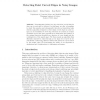Free Online Productivity Tools
i2Speak
i2Symbol
i2OCR
iTex2Img
iWeb2Print
iWeb2Shot
i2Type
iPdf2Split
iPdf2Merge
i2Bopomofo
i2Arabic
i2Style
i2Image
i2PDF
iLatex2Rtf
Sci2ools
113
click to vote
ECCV
2010
Springer
2010
Springer
Detecting Faint Curved Edges in Noisy Images
A fundamental question for edge detection is how faint an edge can be and still be detected. In this paper we offer a formalism to study this question and subsequently introduce a hierarchical edge detection algorithm designed to detect faint curved edges in noisy images. In our formalism we view edge detection as a search in a space of feasible curves, and derive expressions to characterize the behavior of the optimal detection threshold as a function of curve length and the combinatorics of the search space. We then present an algorithm that efficiently searches for edges through a very large set of curves by hierarchically constructing difference filters that match the curves traced by the sought edges. We demonstrate the utility of our algorithm in simulations and in applications to challenging real images.
Related Content
| Added | 11 Jul 2010 |
| Updated | 11 Jul 2010 |
| Type | Conference |
| Year | 2010 |
| Where | ECCV |
Comments (0)

